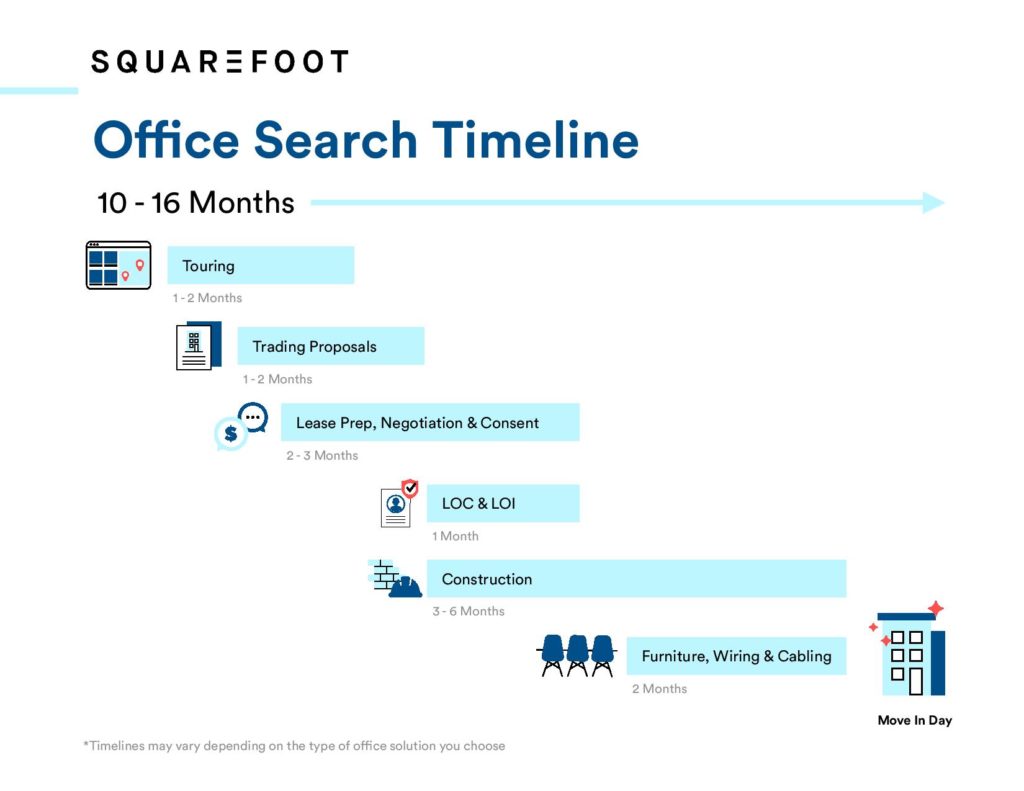Whether you’re navigating the office space market for the first time or you’ve moved your business before, it’s crucial that you ask the right questions throughout the leasing process to ensure that there are no surprises down the line. Here are 12 questions to ask when leasing office space—and certainly before signing on the dotted line!
About the office space and amenities
1. How much office space do I need?
The answer to this question is far from obvious, even if you’ve moved offices multiple times. If you’re a small company and expect to grow, you need to do some projections on headcount so that you look for the right amount of office space. You may even decide you don’t need an entire office for your company and opt for shared space solutions like PivotDesk.
You should also brush up on how to allocate square footage per employee. This can vary greatly by industry. Despite the modern popularity of the open office, many industries still vary in their floor plan, privacy, and space allocation requirements. For example, lawyers who frequently have confidential discussions with clients need a different arrangement than a collaborative marketing team that primarily works on computers. And regardless of the industry, you’ll have to think about how many visitors, such as business partners or clients, might be on-site at any given time.
The general rule of thumb is to allocate 150 square feet per employee, but for a more granular analysis, consider using our office space calculator to see how much space your business needs. You don’t want to pay a higher monthly cost than necessary for space you don’t need, so keep square footage specifications high on your list of priorities.
2. How will the move affect employees’ commutes?
Before starting to view commercial spaces, check with your team to get a sense of what they’re looking for in an office location. Most employees prefer to work in an office that they can easily get to from home and that is close to plenty of restaurants, parking, and other amenities.
While you aren’t going to please everyone, it does pay to include your employees in the selection process — by doing so, you’ll avoid pursuing office options that are going to make your employees unhappy. They’ll also recognize that you care about their well-being and are considering their commutes in your office search process.
3. What’s the building like?
When looking for a new workplace, companies tend to focus on the actual office space. But anyone who has endured an endless morning elevator wait knows that the building itself can make or break an office experience. Asking—and answering—the following questions on all building tours can unearth potential issues, save your company money and make your next work environment much more pleasant.
- If you were a visitor, would you know where to go? Not every building has an obvious path to the elevators or suites. You probably don’t want clients and delivery people to navigate a labyrinth.
- What’s the lobby like? You’ll want to know if it’s attended (or not), security measures during and after work hours, and whether the size might hinder the flow of foot traffic. Also, if impressing clients is important to your business, does it suit your style?
- What’s the after-hours protocol? Here, two things matter most: safety and access. So, are there security personnel, cameras, and/or doors that lock? And can team members access the building on weekends if necessary?
- How many floors and tenants are in the building? This is especially relevant when you realize commercial leases often involve splitting building costs with other tenants. The answer also impacts elevator performance.
- Speaking of, how is elevator performance? If there’s a lone lift, expect a wait to get to your floor. Also determine whether you care if the elevator opens directly into your office or, as is often the case with suites, in front of other businesses.
- Who are the other tenants in the building? This is important to know to understand whether any competitors are in the immediate vicinity. Additionally, this may help you get a sense of the overall building environment.
- How does freight access work? This is especially important if your business regularly moves large quantities of goods, but is also helpful for the move-in process.
- What’s parking like? Especially in cities like Los Angeles where most people drive to get around, parking access will be crucial to your comfort (and the comfort of visitors) in your new office.
- What amenities are included? Amenities offered will vary based on the building, but could include shared recreation areas, shared conference rooms, rooftop access, reception and concierge services, 24/7 security, and more. Understand what amenities are important to your business so you can prioritize buildings that offer them.
4. Do I need to hire an architect, designer, both, or neither?
When you rent a new office space, you’ll want to put together the right external team to customize your workplace. Typically, companies work with architects and designers to turn their visions into reality.
Architects are concerned with a building’s structure and the spatial relationships, both within and outside the building. Their skills cover design, engineering, and managing construction projects (to name a few).
Interior designers are strictly concerned with the space inside of buildings, but they, too, can help establish spatial relationships and manage remodeling projects, such as the construction or removal of walls and partitions.
For typical TAMI (technology, advertising, media, and information) tenants, for example, an interior designer may very well satisfy their build-out needs. For large-scale or specialized companies with unique space requirements, an architect might be best suited to re-imagine the space and come up with the structural changes to support their vision.
It is fairly common to employ both an architect and an interior designer. Their skills complement each other and they are used to working with each other.
However, if neither is in your budget, there are many office layout planning tips to help you conduct the design process yourself.
5. What are my priorities for finding a new office?
What is most important to you when it comes to leasing office space? Is it price? Amenities and services? Lease term? Take time to think about exactly what you want for the future of your business—then consider what it costs and how to get it.
Keep in mind that your priorities may shift throughout the process. For example, easy commutes might be your number one priority going into the search… until you start to tour office spaces in the “optimal” location and find that none feel like the right fit for your company and goals. Or, maybe you thought neighborhood character was most important, but a building on the other side of town offered a deal too good to resist.
It’s also crucial to think about the length of the lease term you want. Are you willing to sign a 3-5 year lease, or do you want more flexibility for your business? If the latter is true, you may choose to focus on other types of office space, such as coworking solutions or shared space, at first. (Not sure whether to choose coworking or traditional space? Learn more about the pros and cons of each.)
Whether you need a new office in the next month or you haven’t begun looking yet, identifying your top priorities now will enable you to recognize which spaces would be a good fit. That said, don’t be surprised if your priorities change!
6. What is the usable square footage of the space?
When considering spaces, be aware of the loss factor, or the percentage difference between rentable square footage and usable square footage. Usable square footage, or “USF”, is space you are able to use as you please, such as conference room space, open seating areas, lounge space, etc. Rentable square footage, or “RSF”, on the other hand, is space that you pay for but that you’re not actually actively using for your business — think fire stairs, electrical closets, utility rooms, lobby space, etc.
When a landlord quotes you the square footage of a space, make sure you ask what portion of it is actually usable by you and your team.

About working with a tenant broker
7. How do I find the right commercial tenant broker?
“Tenant” is the keyword here. If you were to call the phone number on a “space for lease” sign, for example, you would find that almost always, the broker or agent on the other end of the phone represents the landlord, not you. Everything—the spaces listed, the lease terms, the information provided—serve to put the landlord and his broker at an advantage and put more money into their pockets.
A commercial tenant broker, on the other hand, will represent you and look out for your financial and business interests. If you’re part of a big enough company, tenant brokers will often come to you—usually after they read about you in the news. For the average business owner, though, that isn’t the case.
Finding a commercial tenant broker, just as it is in residential real estate, will likely start with finding listings that interest you. Finding quality office space listings you’d like to rent should lead to finding quality tenant brokers who can show you the space and others like it.
Until fairly recently, finding high-quality office and retail space listings was touch and go. As commercial real estate evolves, tenants can expect to find more comparable experiences to residential real estate online. At SquareFoot, our unmatched database of commercial real estate listings and in-house team of expert tenant brokers allow us to streamline the office search process for our clients.
As you continue through the process, your tenant broker will negotiate for you and help you find your perfect office with the best possible terms.
Don’t worry about hefty brokers’ fees: In commercial real estate, landlords typically pay your tenant broker’s fee — meaning that working with a tenant broker comes at no cost to you. Typically, the landlord’s broker or listing agent and the tenant’s broker each take a percentage of the commission on a closed deal. There can be nuances to the structure of the deal, but by and large, the tenant is not responsible for paying the broker.

About leasing and rental costs
8. How do I get free rent and concessions?
“Free rent” usually comes in the form of a Tenant Improvement Allowance (TIA), a monetary contribution the landlord may give businesses to help fund renovations and improvements to a building. Make sure you ask if a TIA clause is included before signing a commercial lease.
9. What’s included in my rent?
When the landlord quotes you a monthly rental price or a price per square foot, make sure you understand what it includes and what isn’t covered by your rent. Typically, costs that landlords offload to rental tenants include:
- Taxes and insurance
- Utilities
- Maintenance expenses
- Repairs
What you’ll pay depends on what type of lease agreement the landlord uses. Before signing a lease, thoroughly review and discuss the lease with your tenant broker to understand what you’ll be on the hook for. Some other specific things to ask about would be HVAC costs (for both shared spaces as well as your own space) and on-site maintenance and cleaning costs.
Make sure to also ask about any office leasing costs outside of your monthly rent that may come up along the lifetime of your lease.
Additionally, you’ll want to ask about who’s covering those costs that come up prior to move-in, such as renovations, repairs, additions to the space, telecommunications installations, and more.
10. Will my costs increase over the lifetime of my lease?
The amount you’ll pay in office rent for the first year may not be the amount you pay going forward, so it’s important to understand what your rental costs will look like over the lifetime of your lease term. A few scenarios in which your costs may increase are:
- If your lease includes an escalation clause, which determines when and how a landlord will increase your rent during your lease term.
- If your lease contains a base year clause that requires you to pay a pro-rata share of increased operating expenses after the first year
Make sure you are aware of any upcoming cost increases and have your tenant broker negotiate these on your behalf.
11. How long is the whole leasing process going to take?
How much time does it take to find office space? This is arguably one of the most important questions to ask. If you don’t mind taking a lot of time, you may be able to either wait for just the right opportunity or to renovate an almost-perfect commercial property to meet your needs. If you need a quick solution, you may opt for a month-to-month coworking space in the short term while you continue your search for a longer-term space.
As a general rule, for traditional office space, ten to sixteen months is a realistic timeframe between the day you start looking for office space and when you can move into a finished space. That’s even with the help of a knowledgeable, dedicated broker. Deals that seem like a sure thing can fall through at the last minute, renovations can take longer than anticipated… even getting signatures on a lease can be a protracted step in the process.
However, this is timeline is highly dependent on the type of office space you’re planning on occupying. Based on the office solution you choose, this number can change drastically. For example, if you’re looking into shared space solutions, you’ll likely not have to deal with any renovations or complicated lease agreements. As always, your broker will be able to advise you on what timeline you can expect for your specific needs.
This timeline showcases the typical length of the leasing process for direct office space:

12. Can I sublease my office space?
Life is full of surprises, and one surprise that you might encounter is one day finding that your new office space no longer suits your needs. Let’s say, for example, that business changes mean your team needs to scale up or down. Your office no longer works for your current company — either because it’s too big and you’re paying for more than you need, or because you need a bigger space to house your team. If your lease prohibits subleasing your office space, you’re stuck paying for a space that just isn’t the right fit. (There are other options for breaking a commercial lease, but the option to sublease can be a great way to minimize costs.)
Some landlords may allow subleasing but have specific requirements about the subletting tenant. This is something you should also ask about prior to leasing space.

Now that you know the main commercial real estate questions to ask, it’s time to find the answers! Contact one of our experienced brokers, who will help you find available rental properties that fit your business needs.





